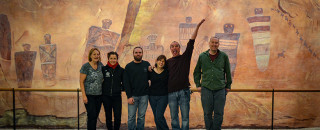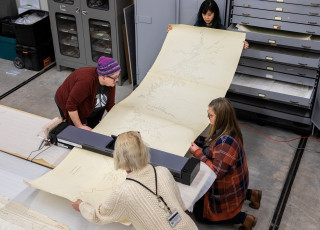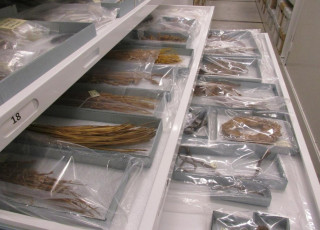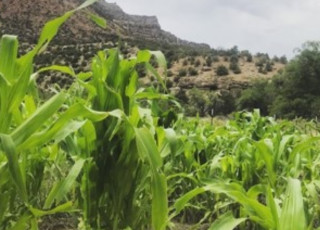Irons, Paint & Pulleys
By Michael Mozdy
For 40 years, Lynn Fausett’s 1940 Barrier Canyon Mural hung in the Anthropology Hall at the George Thomas Building, the former location of the Utah Museum of Natural History. Two large windows shined light on the back of the unprotected, 60-foot mural for those 40 years, and the dust of decades clung to both sides.
When it was time to move the mural to NHMU’s new location in the Rio Tinto Building in Research Park, a great deal of planning and care was in order. Years before the move, the anthropology team had some specialists visit the museum, examine the mural, and make recommendations. When they could not secure a grant to help cover the costs, Glenna Nielsen-Grimm, NHMU’s Anthropology Collections Manager, took the bull by the horns and came up with a plan for conserving and moving the mural.
Dr. Nancy Odegaard, Conservator-Professsor at the Arizona State Museum, University of Arizona, was hired as a consultant for the project. After examining the mural and identifying the many cracks and peeling paint on the giant canvas, she outlined some conservation steps that would need to be taken in order to safely move the work of art. With Odegaard’s supervision and training, NHMU anthropology collections staff stabilized and cleaned the mural over a three-month period. This prepared the mural for the de-installation, move, and installation in the new building in time for the November 2011 opening.
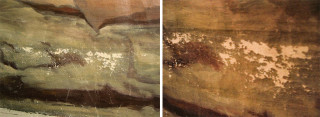
Removing the Dust
Cleaning a painted canvas can be tricky, especially when the canvas is old and the paint is fragile. The team first performed a vacuuming of the back surface followed by gentle brushing over the stable areas of the mural on the front. Next, they used barely damp sponges to carefully remove any remaining dirt from the 70-year-old canvas, top to bottom.
“The back of the canvas, in particular, was filthy,” recalls Nielsen-Grimm.

Ironing on the Paint
Interestingly, the professional conservator consulted on the project recommended using hot tacking irons to help the paint flakes re-adhere to the canvas. Using Lascaux welding powder 5060 (a consolidant used for securing paint flakes, textile fibers, and leather), the NHMU team meticulously went about re-adhering paint by heating patches of the mural where paint was peeling away. When needed, Lascaux powder was applied between the paint flake and the canvas mural to meld the paint to the surface. However, in most cases, just the heated tacking iron applied to the paint was enough to secure the paint. This succeeded in significantly stabilizing the artwork.
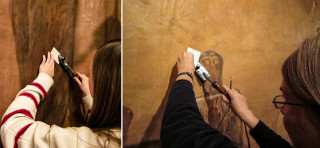
Lowering the Mural
The next step involved getting the 60-foot mural off of the wall. Thankfully, the Anthropology Hall was a massive room, and the team was able to bring in dozens of tables to receive the mural as it was lowered via a pulley system and lots of helping hands. The system used to lower the mural, and also to move and reinstall the mural was designed with the help of Mage Winds Productions, LLC (specialists in rigging), and the theater track was installed by Oasis Stage Werks. After lowering, the top and bottom edges of the mural were stabilized allowing new canvas to be sewn onto the top and bottom of the canvas so that it could be rehung in the new building.
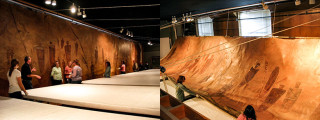
Sewing on a New Edge
A specialized theater track was installed in the new building, which required that the mural would be hung in a new way. To accomplish this, we had to add a new edge. Using an industrial sewing machine moved by hand, the team added a three-inch piece of white fabric across the top and bottom of the mural while it lay on the tables. Existing grommets were stabilized and new ones were added to this piece of fabric so it could attach to hooks in the new building.
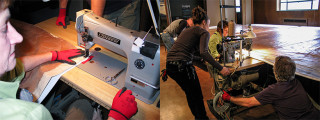
Rolling it Up
The team applied Tyvek® (a polyolefin based white plastic sheeting often used in home construction) to the mural as a way to protect the art. A giant roll on a pivoting stand was made especially for the move, and the next step was to get the Tyvek-covered mural onto the roll. The team carefully rolled the mural onto the spool, securing it with thread to the spool to prevent it from coming loose or curling under. Once the mural was completely on the spool, it was further protected with foam and an outer covering of rigid paperboard.
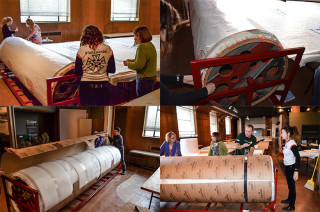
Standing it Up and Installing
At the new building, the giant roll was moved into position, and then with the help of pulleys, stood up at one end of the wall. Standing on scaffolding, staff attached hooks to the new edge and hung it on the theater-style track as they slowly unrolled the mural. The motorized track allows the mural to be moved all at once as it is rotated through the display area. The wall at the new location is 35 feet long, which does not allow for the entire mural to be visible at any one time. We move the mural periodically to reveal different sections during the year.
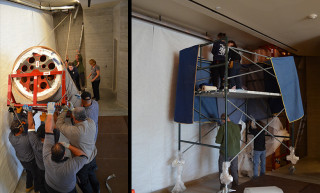

While it was a lot of work, Nielsen-Grimm is very proud of the team’s efforts. “In addition to cleaning, we significantly stabilized the mural,” she reminisces, “and I can’t think of a better way to have welcomed it into its new home.”
Visitors can see the mural on NHMU’s first floor, behind the Admissions Desk. Read more about the creation of the mural in NHMU’s Barrier Canyon Mural, and read about the rock art that inspired the work in Bold Figures, Blurred History.
Michael Mozdy is a Digital Science Writer for The Natural History Museum of Utah, a part of the University of Utah in Salt Lake City. Our mission is to illuminate the natural world and the place of humans within it. In addition to housing outstanding exhibits for the public, NHMU is a research museum. Learn more.
